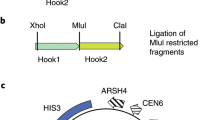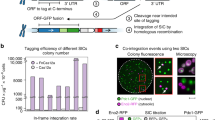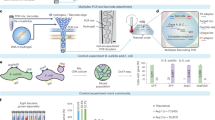Abstract
The capture of metagenomic DNA in large clone libraries provides the opportunity to study microbial diversity that is inaccessible using culture-dependent methods. In this study, we harnessed nuclease-deficient Cas9 to establish a CRISPR counter-selection interruption circuit (CCIC) that can be used to retrieve target clones from complex libraries. Combining modern sequencing methods with CCIC cloning allows for rapid physical access to the genetic diversity present in natural ecosystems.
This is a preview of subscription content, access via your institution
Access options
Access Nature and 54 other Nature Portfolio journals
Get Nature+, our best-value online-access subscription
$29.99 / 30 days
cancel any time
Subscribe to this journal
Receive 12 print issues and online access
$209.00 per year
only $17.42 per issue
Buy this article
- Purchase on Springer Link
- Instant access to full article PDF
Prices may be subject to local taxes which are calculated during checkout


Similar content being viewed by others
Data availability
pCCIC has been deposited as GenBank ON804120. Recovered BGC clusters containing cosmid clones have been deposited as GenBank ON996267–ON996333 and OP058960. The S. albidoflavus J1074 reference genome used is publicly available as GenBank CP004370. The Comprehensive Antibiotic Resistance Database, used for antibiotic resistance analysis of sucrose escape clones, is publically available at https://card.mcmaster.ca. Other data are available from the corresponding authors upon reasonable request. Source data are provided with this paper.
Code availability
Publicly available Flye version 2.9-b1768, antiSMASH 5.1, Defense Finder 1.0.8, SeqKit version 2.1.0, VSEARCH version 2.18.0, minimap2 version 2.24-r1122 and UGENE version 42.0 were used for sequence assembly and analysis. Custom code generated for edge mapping has been deposited in Zenodo (https://doi.org/10.5281/zenodo.6574918).
References
Wang, J.Y., Pausch, P. & Doudna, J.A. Structural biology of CRISPR–Cas immunity and genome editing enzymes. Nat. Rev. Microbiol. 20, 641–656 (2022).
Xu, X. & Qi, L. S. A CRISPR–dCas toolbox for genetic engineering and synthetic biology. J. Mol. Biol. 431, 34–47 (2019).
Adli, M. The CRISPR tool kit for genome editing and beyond. Nat. Commun. 9, 1911 (2018).
Jinek, M. et al. A programmable dual-RNA-guided DNA endonuclease in adaptive bacterial immunity. Science 337, 816–821 (2012).
Bikard, D. et al. Programmable repression and activation of bacterial gene expression using an engineered CRISPR–Cas system. Nucleic Acids Res. 41, 7429–7437 (2013).
Schultzhaus, Z., Wang, Z. & Stenger, D. CRISPR-based enrichment strategies for targeted sequencing. Biotechnol. Adv. 46, 107672 (2021).
Feldman, D. et al. CloneSifter: enrichment of rare clones from heterogeneous cell populations. BMC Biol. 18, 177 (2020).
Li, S. et al. CRISPRi chemical genetics and comparative genomics identify genes mediating drug potency in Mycobacterium tuberculosis. Nat. Microbiol. 7, 766–779 (2022).
Jost, M. et al. Combined CRISPRi/a-based chemical genetic screens reveal that rigosertib is a microtubule-destabilizing agent. Mol. Cell 68, 210–223 (2017).
Owen, J. G. et al. Multiplexed metagenome mining using short DNA sequence tags facilitates targeted discovery of epoxyketone proteasome inhibitors. Proc. Natl Acad. Sci. USA 112, 4221–4226 (2015).
Jiang, W. et al. Cas9-Assisted Targeting of CHromosome segments CATCH enables one-step targeted cloning of large gene clusters. Nat. Commun. 6, 8101 (2015).
Lee, N. C., Larionov, V. & Kouprina, N. Highly efficient CRISPR/Cas9-mediated TAR cloning of genes and chromosomal loci from complex genomes in yeast. Nucleic Acids Res. 43, e55 (2015).
Wang, H. et al. ExoCET: exonuclease in vitro assembly combined with RecET recombination for highly efficient direct DNA cloning from complex genomes. Nucleic Acids Res. 46, e28 (2018).
Eid, J. et al. Real-time DNA sequencing from single polymerase molecules. Science 323, 133–138 (2009).
Burian, J. & Thompson, C. J. Regulatory genes coordinating antibiotic-induced changes in promoter activity and early transcriptional termination of the mycobacterial intrinsic resistance gene whiB7. Mol. Microbiol. 107, 402–415 (2018).
Pierce, J. C., Sauer, B. & Sternberg, N. A positive selection vector for cloning high molecular weight DNA by the bacteriophage P1 system: improved cloning efficacy. Proc. Natl Acad. Sci. USA 89, 2056–2060 (1992).
Gay, P., Le Coq, D., Steinmetz, M., Berkelman, T. & Kado, C. I. Positive selection procedure for entrapment of insertion sequence elements in gram-negative bacteria. J. Bacteriol. 164, 918–921 (1985).
Brady, S. F. Construction of soil environmental DNA cosmid libraries and screening for clones that produce biologically active small molecules. Nat. Protoc. 2, 1297–1305 (2007).
Haley, J. D. in New Nucleic Acid Techniques (ed Walker, J. M.) 257–283 (Humana Press, 1988).
Blin, K. et al. antiSMASH 6.0: improving cluster detection and comparison capabilities. Nucleic Acids Res. 49, W29–W35 (2021).
Tesson, F. et al. Systematic and quantitative view of the antiviral arsenal of prokaryotes. Nat. Commun. 13, 2561 (2022).
Calvo-Villamanan, A. et al. On-target activity predictions enable improved CRISPR–dCas9 screens in bacteria. Nucleic Acids Res. 48, e64 (2020).
Wang, W., Zheng, G. & Lu, Y. Recent advances in strategies for the cloning of natural product biosynthetic gene clusters. Front. Bioeng. Biotechnol. 9, 692797 (2021).
Picelli, S. et al. Tn5 transposase and tagmentation procedures for massively scaled sequencing projects. Genome Res. 24, 2033–2040 (2014).
Athanasopoulou, K., Boti, M. A., Adamopoulos, P. G., Skourou, P. C. & Scorilas, A. Third-generation sequencing: the spearhead towards the radical transformation of modern genomics. Life (Basel) 12, 30 (2021).
Sternberg, N., Ruether, J. & deRiel, K. Generation of a 50,000-member human DNA library with an average DNA insert size of 75-100 kbp in a bacteriophage P1 cloning vector. New Biol. 2, 151–162 (1990).
Zaburannyi, N., Rabyk, M., Ostash, B., Fedorenko, V. & Luzhetskyy, A. Insights into naturally minimised Streptomyces albus J1074 genome. BMC Genomics 15, 97 (2014).
Wu, C., Shang, Z., Lemetre, C., Ternei, M. A. & Brady, S. F. Cadasides, Calcium-dependent acidic lipopeptides from the soil metagenome that are active against multidrug-resistant bacteria. J. Am. Chem. Soc. 141, 3910–3919 (2019).
Jiang, Y. et al. Multigene editing in the Escherichia coli genome via the CRISPR–Cas9 system. Appl. Environ. Microbiol. 81, 2506–2514 (2015).
Chang, A. C. & Cohen, S. N. Construction and characterization of amplifiable multicopy DNA cloning vehicles derived from the P15A cryptic miniplasmid. J. Bacteriol. 134, 1141–1156 (1978).
Qi, L. S. et al. Repurposing CRISPR as an RNA-guided platform for sequence-specific control of gene expression. Cell 152, 1173–1183 (2013).
Cohen, S. N., Chang, A. C., Boyer, H. W. & Helling, R. B. Construction of biologically functional bacterial plasmids in vitro. Proc. Natl Acad. Sci. USA 70, 3240–3244 (1973).
Doench, J. G. et al. Rational design of highly active sgRNAs for CRISPR–Cas9-mediated gene inactivation. Nat. Biotechnol. 32, 1262–1267 (2014).
Chan, W. T., Verma, C. S., Lane, D. P. & Gan, S. K. A comparison and optimization of methods and factors affecting the transformation of Escherichia coli. Biosci. Rep. 33, e00086 (2013).
Kolmogorov, M. et al. metaFlye: scalable long-read metagenome assembly using repeat graphs. Nat. Methods 17, 1103–1110 (2020).
Blin, K. et al. antiSMASH 5.0: updates to the secondary metabolite genome mining pipeline. Nucleic Acids Res. 47, W81–W87 (2019).
Shen, W., Le, S., Li, Y. & Hu, F. SeqKit: a cross-platform and ultrafast toolkit for FASTA/Q file manipulation. PLoS ONE 11, e0163962 (2016).
Rognes, T., Flouri, T., Nichols, B., Quince, C. & Mahe, F. VSEARCH: a versatile open source tool for metagenomics. PeerJ 4, e2584 (2016).
Okonechnikov, K., Golosova, O., Fursov, M. & UGENE Team. Unipro UGENE: a unified bioinformatics toolkit. Bioinformatics 28, 1166–1167 (2012).
Acknowledgements
This work was supported by National Institutes of Health grant 5R35GM122559 (S.F.B.). We thank the Marraffini laboratory for pdCas9. Vectors pCas (Addgene, 62225) and pTargetF (Addgene, 62226) were gifts from Sheng Yang, and pwtCas9-bacteria (Addgene, 44250) was a gift from Stanley Qi. PacBio sequencing was performed by the Rockefeller University Vertebrate Genome Center.
Author information
Authors and Affiliations
Contributions
J.B., V.K.L. and S.F.B. conceived CCIC retrieval. J.B. and S.F.B. designed and analyzed experiments. J.B. performed all experiments, with the aid of M.A.T. for metagenomic DNA preparation and lambda packaging, L.G. for various cloning and Y.A.H. for bioinformatics.
Corresponding author
Ethics declarations
Competing interests
S.F.B. has consulted for Zymergen. All other authors declare no competing interests.
Peer review
Peer review information
Nature Biotechnology thanks Benjamin Rubin and the other, anonymous, reviewer(s) for their contribution to the peer review of this work.
Additional information
Publisher’s note Springer Nature remains neutral with regard to jurisdictional claims in published maps and institutional affiliations.
Supplementary information
Supplementary Information
Supplementary Methods, Supplementary Figs. 1–7 and Supplementary Notes 1–3
Supplementary Table
Supplementary Tables 1–6
Source data
Source Data Fig. 1
Source/raw data
Source Data Extended Data Fig. 1
Source/raw data
Source Data Extended Data Fig. 3
Source/raw data
Source Data Extended Data Fig. 4
Source/raw data
Rights and permissions
Springer Nature or its licensor (e.g. a society or other partner) holds exclusive rights to this article under a publishing agreement with the author(s) or other rightsholder(s); author self-archiving of the accepted manuscript version of this article is solely governed by the terms of such publishing agreement and applicable law.
About this article
Cite this article
Burian, J., Libis, V.K., Hernandez, Y.A. et al. High-throughput retrieval of target sequences from complex clone libraries using CRISPRi. Nat Biotechnol 41, 626–630 (2023). https://doi.org/10.1038/s41587-022-01531-8
Received:
Accepted:
Published:
Issue Date:
DOI: https://doi.org/10.1038/s41587-022-01531-8
This article is cited by
-
Programming bacteria for multiplexed DNA detection
Nature Communications (2023)



